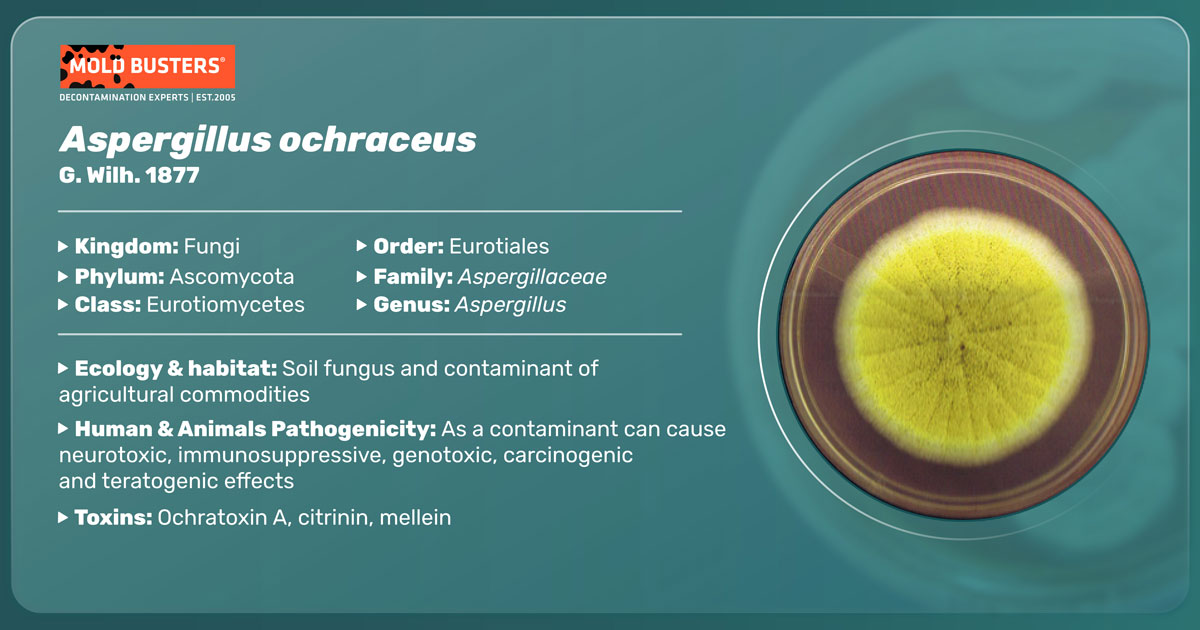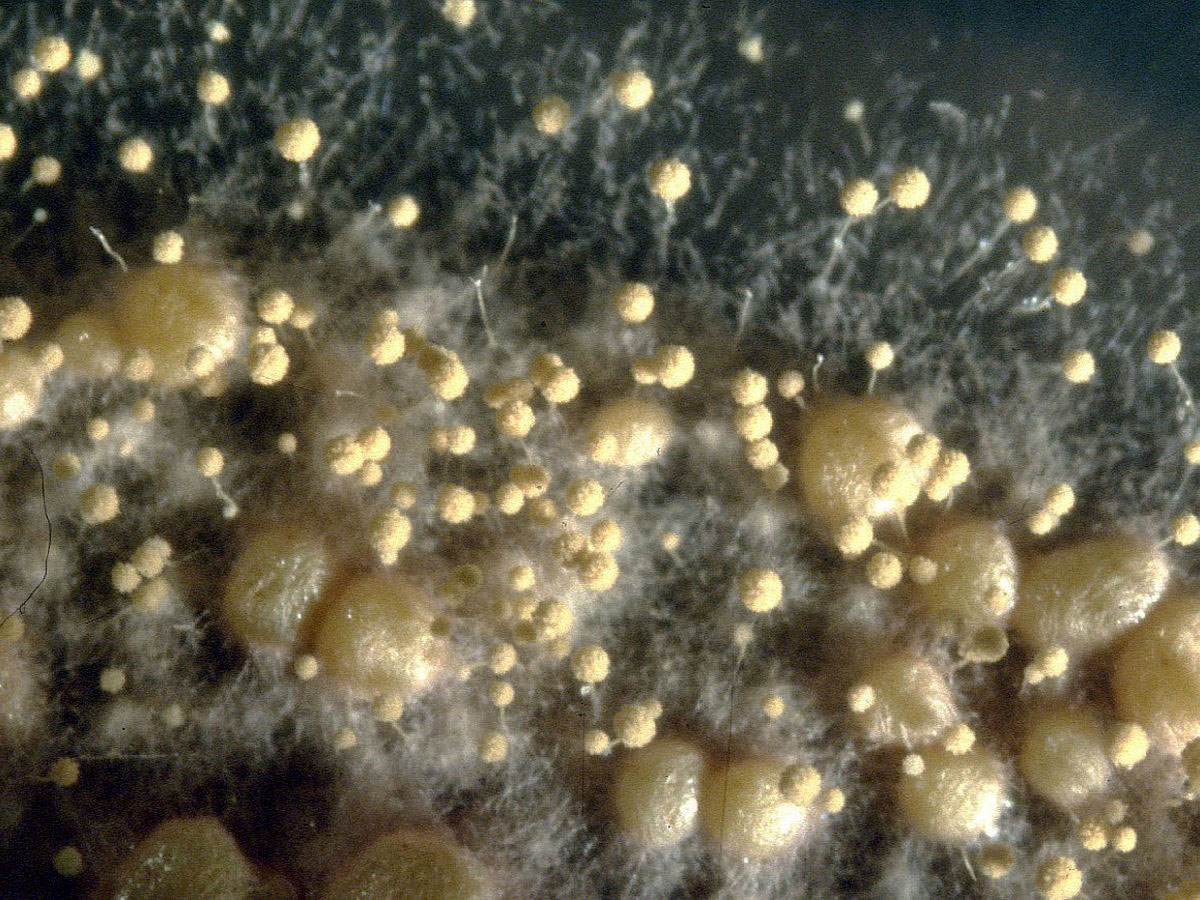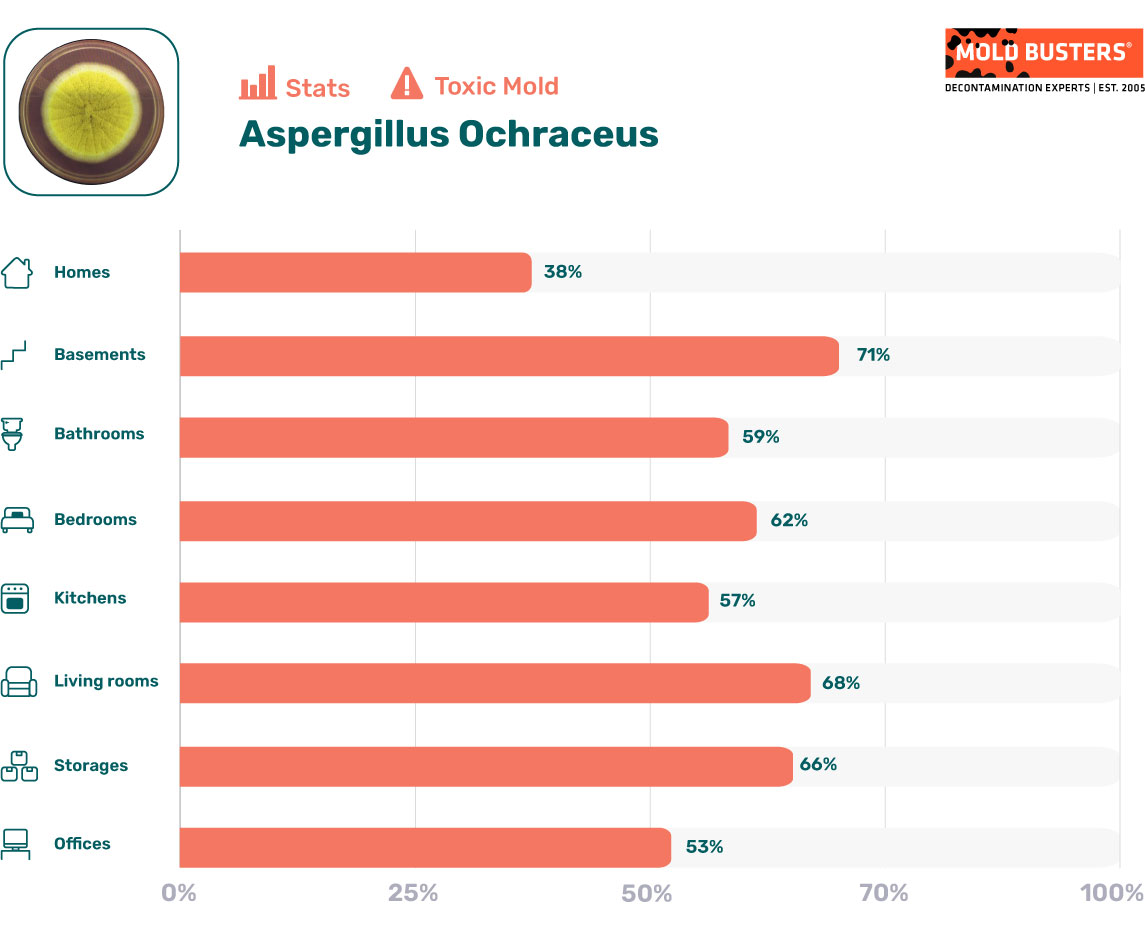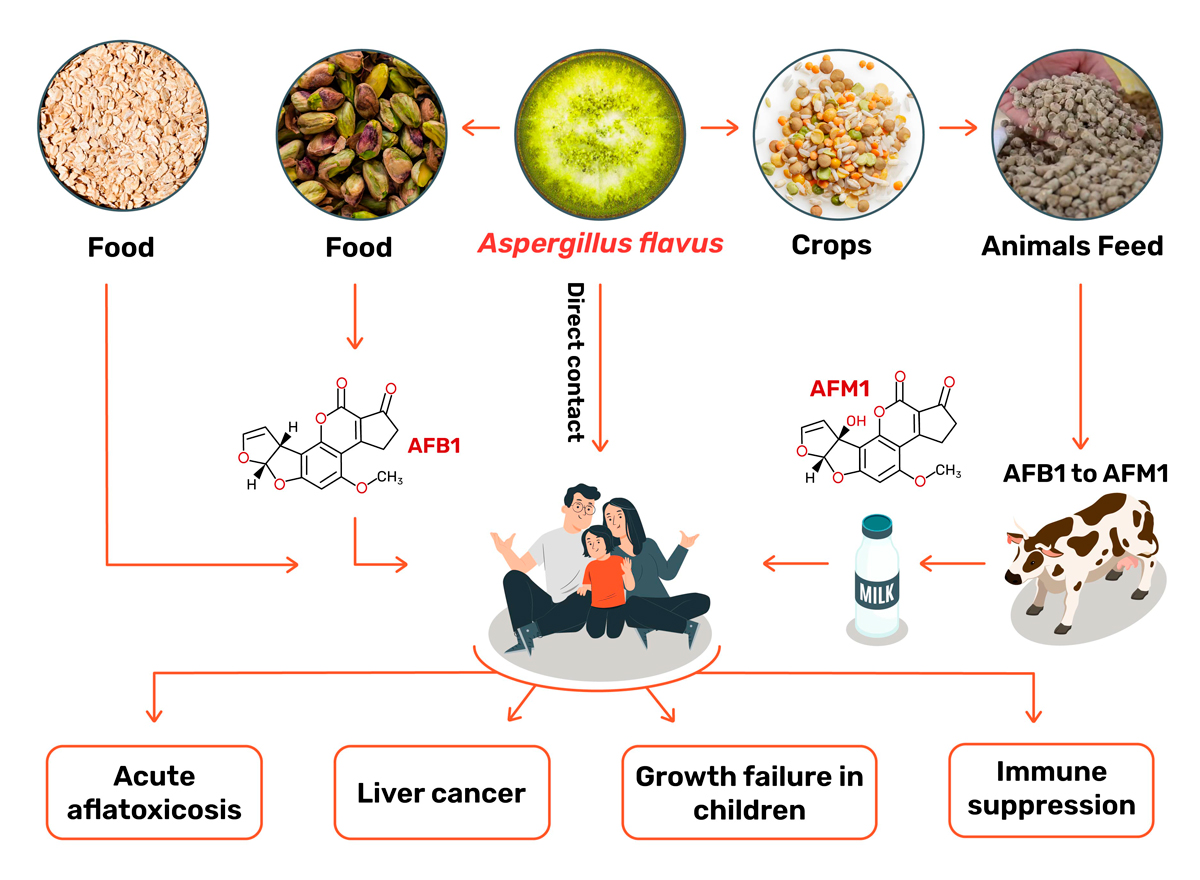G. Wilh. 1877
A member of the Aspergillus genus, Aspergillus ochraceus is a frequent mold contaminant of grain, and dried food products. It is a ubiquitous resident of soil and living and decaying plant matter. This species produces ochratoxin A, a potent mycotoxin that can cause serious kidney damage.

Where does Aspergillus ochraceus mold grow?
A. ochraceus can grow in a variety of environments, particularly in warm, damp places. It is able to grow at temperatures ranging between 8–37°C (46–98°F), with the optimum between 24-31°C (75–87°F). They require a significant level of moisture to develop, and are best adapted to water activity levels between 0.95-0.99 [1]. Places such as basements, attics, ventilation units, air vents, storage cupboards, bathrooms, laundry rooms, are all potential spots for mold development.
Aspergillus ochraceus morphology
Aspergillus ochraceus is a rapid grower, forming colonies of 45–55 mm (1.7-2.1 inches) in a week. Vegetative mycelium is mostly submerged in the agar, while the conidial heads protrude and are usually arranged in zones. The typical colony color is white to yellow. Some strains may form sclerotia (Fig. 1). Conidia are spherical, 2.5–3.5 µm diameter, with smooth to slightly roughened walls. They are formed in radiate heads, splitting into two or more broad columns with maturity [1].

What are known species of Aspergillus ochraceus?
A. ochraceus was first described by Karl Adolf Wilhelm in 1877. Subsequently, several other similar species were added to the “Aspergillus ochraceusgroup”. These include A. alutaceus (1875), A. ochraceus var. microspora (1908) and A. ochraceus var. petaliformis (1957).
In 1979 two new species were added to the group – Aspergillus bridgeri, which was discovered in the soils of southern Wyoming, and Aspergillus campestris, first found in North Dakota.
Aspergillus ochraceus mold statistics
As part of the data analysis presented inside our mold statistics resource page, we have calculated how often mold spore types appear in different parts of the indoor environment when mold levels are elevated. Below are the stats for Aspergillus ochraceus:


Aspergillus ochraceus in Cannabis
Like many types of mold, A. ochraceus can also be found growing on a variety of plant life including peanuts, corn, rice, and various types of fruits and tree nuts (Fig. 2). Hemp or cannabis plants can also be affected. The presence of the mold on connected products can cause adverse health effects. There have been several studies highlighting the connection between marijuana use and pulmonary aspergillosis [2–5].

Aspergillus ochraceus and your health
A. ochraceus spores are considered to be allergens and irritants, causing hypersensitivity pneumonitis and dermatitis. A. ochraceusis also known to produce several mycotoxins, such as ochratoxins, penicillic acid, xanthomegnin and viomellin [1]. Notably, A. ochraceus produces ochratoxin A, a carcinogenic mycotoxin which causes serious kidney damage [6, 7]. The types of diseases caused by A. ochraceus can vary in severity, from allergy-type illnesses to life-threatening infections [8]. Aspergillosis is a collective term for group of diseases caused by fungi of the Aspergillus genus.
Because these symptoms are common to many other illnesses, it is difficult to diagnose aspergillosis without visiting a specialist. The severity of aspergillosis is determined by various factors including the state of a person’s immune system. Although everyone inhales hundreds of spores per day, aspergillosis rarely affects healthy people living in normal conditions as our immune system is more than capable of finding out inhaled mold spores and neutralize them.
What allergies are caused by Aspergillus ochraceus?
A. ochraceus reproduces by disseminating airborne spores. People who are sensitive to fungal spores may experience allergic reactions to them, especially during prolonged exposure.
Symptoms of an allergic reaction to fungal spores include:
- rashes
- difficulty breathing
- coughing
- itchy and bloodshot eyes
- a runny nose
- a sore and itchy throat
What are health effects of Aspergillus ochraceus mold?
Inhaling the spores of this mold, especially in high amounts, can be incredibly dangerous. In worst case scenarios, excessive spore inhalation can lead to permanent health issues, and even fatal outcomes in severely immunocompromised individuals. A. ochraceus spores have also been associated with the onset and development of asthma in young children [9]. Aside from these lung-related conditions, cases of paranasal sinusitis have also been attributed to the inhalation of A. ochraceus spores [8].
Furthermore, A. ochraceus produces a mycotoxin known as ochratoxin A, which can cause serious and potentially life-threatening health issues if inhaled or ingested. A. ochraceus has been reported to be a significant source of ochratoxin A in coffee [10]. Ochratoxins can act as nephrotoxins (kidneys), carcinogens, teratogens (raise the risk of congenital disabilities), and immunotoxins [6].
Treatment and prevention of Aspergillus ochraceus mold
Firstly, there is always the risk of inhaling a potentially dangerous amount of spores during your efforts to get rid of them, whichever method you use.
By yourself, it can be complicated to identify all mold growths in your home and completely eradicate them. Mold can be very persistent and can return soon after it seems completely eradicated. Often, the issue is underlying, and removing the mold will not prevent further colonies from developing. After all, fungal spores are ubiquitous in the air around us and will develop anywhere they find to be suitable.
Once you get in touch with Mold Busters, you can be assured that we will completely remove all mold from your home, wherever it may be growing.
We will do this safely and effectively, and we can provide advice on further steps you can take to ensure the mold doesn’t take root in your home again.
It’s always easier to prevent a mold problem than to deal with it once it gets to you, so it’s well worth the investment to have experts perform a detailed survey of your home even if you’re not too sure what kind of mold you’ve spotted. It’s just one part of making sure your house stays a happy home.
References
- Pitt JI, Hocking AD (2009). Aspergillus and Related Teleomorphs. In: Fungi and Food Spoilage. Springer, Boston, MA, pp 470-471
- Remington TL, Fuller J, Chiu I (2015). Chronic necrotizing pulmonary aspergillosis in a patient with diabetes and marijuana use. CMAJ. 187(17):1305-8.
- Kurup VP, Resnick A, Kagen SL, et al (1983). Allergenic fungi and actinomycetes in smoking materials and their health implications. Mycopathologia 82:61–4.
- Vaschetto R, Kroumova V, Olivieri C, et al (2012). Early diagnosis of invasive pulmonary aspergillosis in a young immunocompetent patient. New Microbiol 35:77–82.
- Bal A, Agarwal AN, Das A, et al (2010). Chronic necrotising pulmonary aspergillosis in a marijuana addict: a new cause of amyloidosis. Pathology 42:197–200.
- Bui-Klimke TR, Wu F (2015). Ochratoxin A and human health risk: a review of the evidence. Crit Rev Food Sci Nutr. 55(13):1860-9.
- Palma N, Cinelli S, Sapora O, Wilson SH, Dogliotti E (2007). Ochratoxin A-induced mutagenesis in mammalian cells is consistent with the production of oxidative stress. Chem Res Toxicol. 20(7):1031-7.
- Howard DH (2003). Pathogenic Fungi in Humans and Animals. Marcel Dekker, New York. pp 294-295.
- Reponen T, Lockey J, Bernstein DI, et al (2012). Infant origins of childhood asthma associated with specific molds. J Allergy Clin Immunol. 130(3):639-644.e5.
- Taniwaki MH, Pitt JI, Teixeira AA, Iamanaka BT (2003). The source of ochratoxin A in Brazilian coffee and its formation in relation to processing methods. Int J Food Microbiol. 82: 173–179.

Get Special Gift: Industry-Standard Mold Removal Guidelines
Download the industry-standard guidelines that Mold Busters use in their own mold removal services, including news, tips and special offers:

Written by:
John Ward
Account Executive
Mold Busters
Edited by:
Dusan Sadikovic
Mycologist – MSc, PhD
Mold Busters
